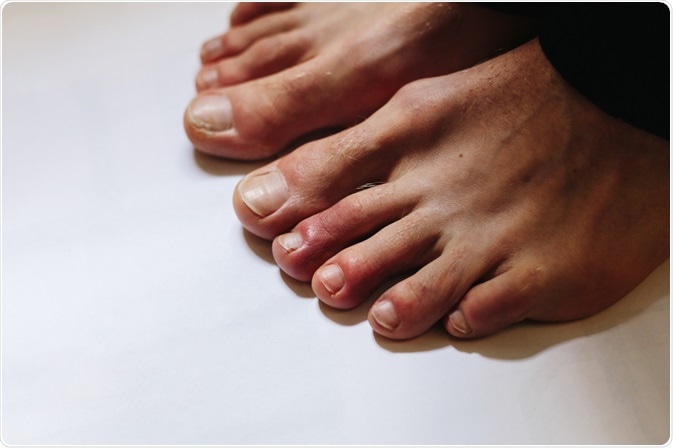What are COVID Toes?

COVID-19 has many commonly discussed symptoms, including coughing and fevers. Other less common symptoms include rashes, discoloration of the skin, and swelling of the toes. While still being investigated, the effects of COVID-19 on the skin seem not to be accompanied by pain or discomfort.

Image Credit: Ternavskaia Olga Alibec/Shutterstock.com
Symptoms of COVID toes
Despite the name, COVID toes can develop on the fingers and toes alike. However, it appears to be more common on the toes. COVID toes begin with a bright red coloration on the fingers or toes, which then gradually turns purple. COVID toes can range from affecting one toe to all of them.
For the most part, COVID toes are painless, and the only reason they can be noticeable is the discoloration. However, for other people, COVID toes can also cause blistering, itch, and pain. On some people, COVID toes will rarely cause raised bumps or patches of rough skin. Some people may also have a build-up of pus under the skin.
As a recently discovered phenomenon, there is not much research on how long COVID toes last. For some people, COVID toes can last around 10 to 14 days, whereas the condition can last for months for others.
COVID toes do not need to be treated to go away but can be treated with some hydrocortisone cream in case of itching or pain. However, if this does not help or if symptoms become worse, it is recommended to visit a health professional.
Causes of COVID toes
It is not entirely clear why COVID toes occur. Some professionals have pointed out that rashes are relatively common when patients are fighting viral infections, especially when they are respiratory in nature. It is believed COVID toes may be an extension of this phenomenon that occurs with COVID-19. Similarly, treatment with antibiotics can cause rashes and other skin issues.
Patients who have been afflicted with this condition have not generally shown signs of Raynaud, which is when areas of the body become numb and cold due to lower temperatures or stress, or ischemia, which is bad blood circulation.
A more detailed analysis of COVID toes reveals several facets of inflammation linked to the condition. Inflammation directed at the vessels, called vasculitis, has been present in moderate to severe levels in around half of the cases that have been studied so far. However, even when inflammation was mild, there was evidence of damage to the vasculature and leaking.
While the exact cause of COVID toes is unknown, there are some theories. These include anomalies in the coagulation pathways, the release of interferons, and possibly external factors. Other theories more directly link to COVID-19 – for example, one theory states that COVID-19 viral particles in skin cells lead to the recruitment of immune cells, which in turn cause bursting.
COVID toes and their link to COVID-19
At first, the link between COVID toes and COVID-19 was tenuous, as many who reported COVID toes did not have positive COVID tests. This has led to the association between COVID toes and COVID-19 to be somewhat correlative, as they have only been generally related to different times in the infection. Some patients, however, have tested positive for COVID-19 when having COVID toes.
Many of the patients who have so far been reported to have COVID toes have not had many other symptoms of COVID-19. Those that have had symptoms have had a mild fever or congestion. Some theories for why this is could be associated with COVID toes with a late stage of the disease, in which case the infection had cleared, and PCR results would be negative. However, lesions of COVID toes have shown evidence of viral particles within the cells of the skin.
It is unclear how COVID toes relate to the contagion of the disease. However, some theorize that the late onset of COVID toes means patients are not generally contagious when they have the condition.
COVID toes are occasionally linked to rashes that can also occur with the disease. These rashes can be patchy, have blister-like appearances, leave a lace-like pattern on the skin, and being itchy.
Sources
- Landa, N., Mendieta‐Eckert, M., Fonda‐Pascual, P., and Aguirre, T., 2020. Chilblain‐like lesions on feet and hands during the COVID‐19 Pandemic. International Journal of Dermatology, 59(6), pp. 739-743.
- Colmenero, I., Santonja, C., Alonso‐Riaño, M., Noguera‐Morel, L., Hernández‐Martín, A., Andina, D., Wiesner, T., Rodríguez‐Peralto, J., Requena, L. and Torrelo, A., 2020. SARS‐CoV‐2 endothelial infection causes COVID‐19 chilblains: histopathological, immunohistochemical and ultrastructural study of seven paediatric cases. British Journal of Dermatology.
- American Academy of Dermatology Association. 2020. COVID Toes, Rashes: How The Coronavirus Can Affect Your Skin. [online] Available at: <https://www.aad.org/public/diseases/coronavirus/covid-toes> [Accessed 14 September 2020].
- Health Essentials from Cleveland Clinic. 2020. Are COVID Toes And Rashes Common Symptoms Of The Coronavirus?. [online] Available at: <https://health.clevelandclinic.org/are-covid-toes-and-rashes-common-symptoms-of-coronavirus/> [Accessed 14 September 2020].
Further Reading
- All Coronavirus Disease COVID-19 Content
- What Mutations of SARS-CoV-2 are Causing Concern?
- What is the Clinical Impact of COVID-19 on Cancer Patients?
- Can Pets Get COVID-19?
- An Overview of the SARS-CoV-2 Vaccines
Last Updated: Jan 20, 2021

Written by
Sara Ryding
Sara is a passionate life sciences writer who specializes in zoology and ornithology. She is currently completing a Ph.D. at Deakin University in Australia which focuses on how the beaks of birds change with global warming.
Source: Read Full Article